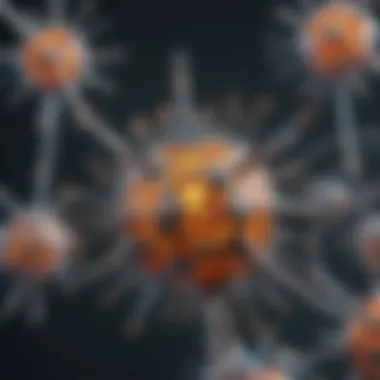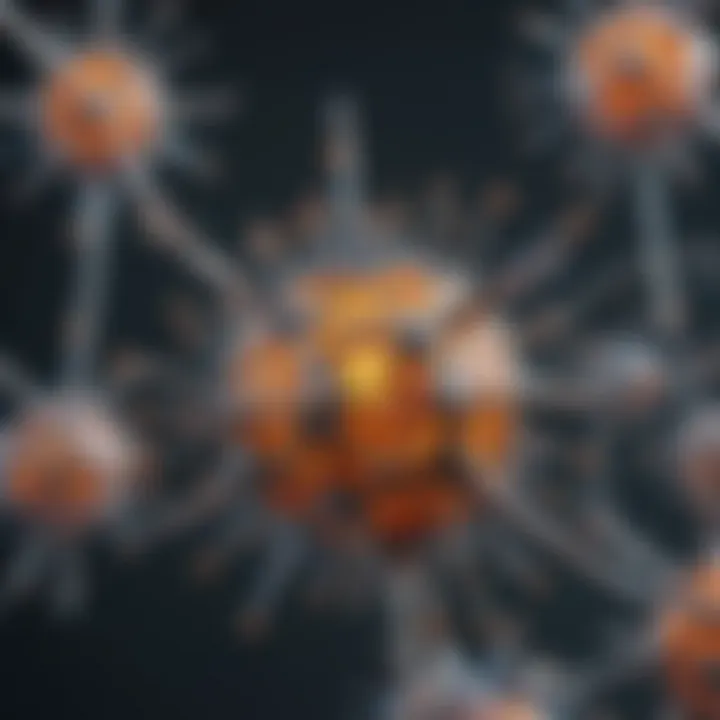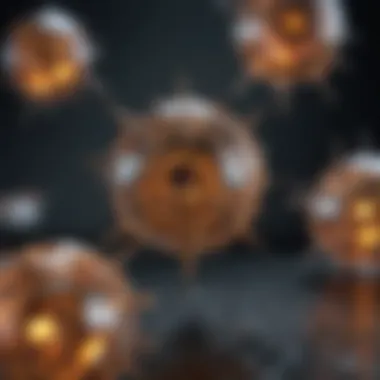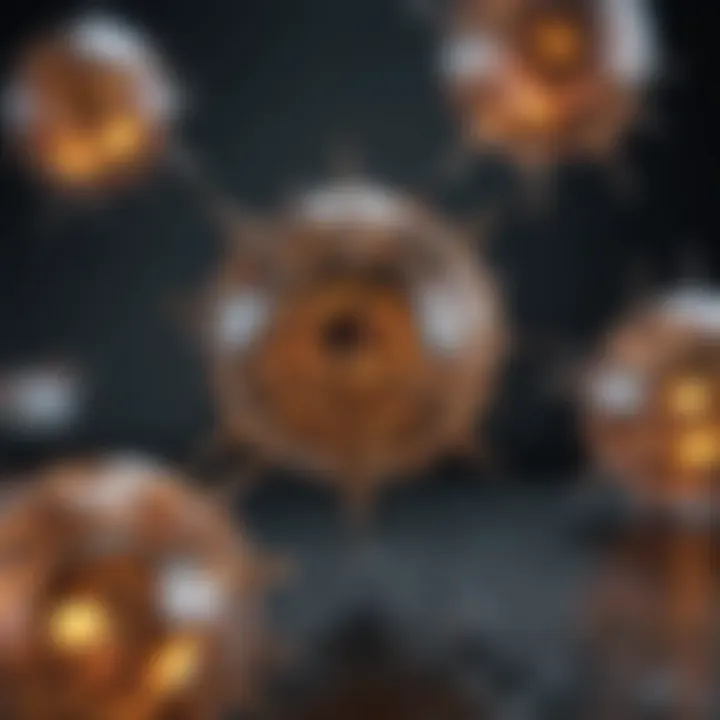Understanding Pegylation: Mechanisms and Applications


Intro
Pegylation is a vital biotechnological process that involves the attachment of polyethylene glycol (PEG) molecules to proteins or drugs. This modification has significant consequences on the pharmacokinetics and therapeutic effectiveness of drugs. Understanding the intricacies of pegylation is crucial for developing advanced drug delivery systems and enhancing therapeutic outcomes. The relevance of this process extends across various sectors in medicine and biotechnology, impacting how treatments are formulated and how effectively they address medical challenges.
In this section, we will uncover the fundamental mechanisms of pegylation, explore its various applications, and discuss the evolving landscape of pegylated compounds. The exploration of pegylation provides insight into modern drug development and personalized medicine, which are becoming increasingly critical in the healthcare arena.
Prelims to Pegylation
Pegylation represents a significant advancement in drug formulation and delivery systems. The process enhances pharmacokinetics and maximizes therapeutic effects. Understanding pegylation is essential for students, researchers, and professionals involved in biotechnology and pharmaceuticals.
In the realm of drug development, pegylation alters the behavior of drugs within the body. By bonding polyethylene glycol (PEG) to drugs or proteins, the solubility and stability of these compounds increase. This leads to improved efficacy, reduced doses, and fewer side effects.
Defining Pegylation
Pegylation is the covalent attachment of PEG molecules to bioactive compounds like proteins or peptides. This modification is crucial for enhancing the pharmacological properties of these compounds. The process can shield the drug from immune recognition, thus prolonging its presence and activity within the bloodstream.
PEG is a hydrophilic polyether compound. When attached to a drug, it alters molecular interactions. The larger the PEG molecule, the more significant the impact on distribution and elimination. Pegylation can be beneficial in many therapeutic contexts including oncology and immunology.
Historical Context
The concept of pegylation emerged in the 1970s. Initially, it was investigated as a means to improve the efficacy of therapeutic proteins. The first successful use of pegylation occurred with PEG-asparaginase, which became widely used for treating acute lymphoblastic leukemia. This marked a turning point in the development of pegylated therapies.
Since then, numerous pegylated drugs have been introduced into the market. These include PEG-interferon for hepatitis C and PEG-filgrastim for neutropenia. Each of these drugs demonstrates the effectiveness of pegylation in enhancing the clinical performance of existing treatments, significantly impacting patient outcomes.
Pegylation has transformed the landscape of biopharmaceuticals by increasing half-life and reducing dosage frequency. This change enhances patient convenience.
Understanding pegylation helps map the future of drug development. It opens doors to innovative therapies by allowing scientists to design drugs with improved performance characteristics.
Mechanisms of Pegylation
The mechanisms of pegylation are crucial for understanding how this modification enhances the properties of pharmaceuticals and biologics. Pegylation can significantly change the behavior of a drug in the body, affecting its absorption, distribution, metabolism, and excretion. Thus, it is vital to discern the underlying mechanisms to optimize therapeutic efficacy and improve patient outcomes.
Chemical Basis
The chemical basis of pegylation involves the conjugation of polyethylene glycol (PEG) to biomolecules through covalent bonds. This process is intricate, as it can require precise conditions to ensure successful attachment. PEG itself comprises various molecular weights, which can influence the outcomes of pegylation. The choice of PEG size is critical because smaller PEGs may lead to faster excretion from the body, while larger PEGs can enhance solubility and stability but can also result in steric hindrance, affecting the drug's accessibility to targets.
Successful pegylation results in a hydrophilic coating that affects the drug's interaction with biological systems. By evaluating the structure and dynamics of PEG molecules, it becomes easier to understand how they interact with proteins and influence their behavior in a biological environment.
Types of Pegylation
The methods of pegylation can be divided into two primary types: site-specific pegylation and random pegylation. Each type has its specific benefits and applications, significantly influencing the resulting product's characteristics.
Site-specific Pegylation
Site-specific pegylation involves the attachment of PEG molecules to designated locations on a protein or drug. This method allows for controlled modifications, enabling researchers to better understand the impact on the therapeutic's activity. One key characteristic of this approach is that it can maintain the protein’s natural functionality because only specific amino acids are targeted for modification. Consequently, this leads to potentially improved therapeutic outcomes.
The advantage of site-specific pegylation lies in its precision, allowing for tailored drug formulations that take advantage of the natural structure of the biomolecule. However, it requires a sophisticated understanding of the protein structure and can be more complex to execute compared to random pegylation.
Random Pegylation
Random pegylation, in contrast, entails the indiscriminate attachment of PEG molecules throughout the biomolecule. This method is often simpler and more cost-effective to implement compared to site-specific methods. A notable advantage is that it can increase the overall hydrophilicity of a protein, improving its solubility in aqueous environments. This characteristic makes random pegylation attractive for a variety of therapeutic applications.
However, the primary downside to random pegylation is that it may alter crucial features of the protein structure. Such unpredictable changes can lead to variability in drug efficacy or even unintended side effects. Therefore, understanding how random pegylation modifies pharmacokinetics is essential for researchers optimizing drug development.
In summary, the mechanisms of pegylation play an integral role in biomedical applications, providing a pathway to enhance drug performance through both site-specific and random approaches. Each method presents distinct benefits and challenges that must be carefully considered in drug formulation and development.
Methods of Pegylation


The methods of pegylation are critical in determining the efficacy and safety of pegylated drugs. These methods facilitate the attachment of polyethylene glycol (PEG) to therapeutic proteins and drugs, impacting their pharmacokinetics and overall therapeutic outcomes. Understanding these methods can also help in selecting the appropriate technique depending on the desired properties of the final product.
Direct Chemical Modification
Direct chemical modification is one of the most straightforward methods for pegylation. In this process, PEG reacts directly with the functional groups of a protein or drug. The reaction can take place under controlled conditions, allowing for specificity. This method is commonly used due to its simplicity and relative cost-effectiveness.
The advantages of direct chemical modification warrant attention. It allows for precise tuning of molecular weight and structure of PEG to enhance solubility and stability. However, it does have limitations, such as potential modifications to the protein’s functional sites that could compromise its biological activity.
Enzymatic Pegylation
Enzymatic pegylation employs the use of enzymes to ensure the attachment of PEG to specific sites on a protein. This method is particularly useful because it can achieve higher specificity than chemical methods. Enzymes such as transglutaminases and sortases are often utilized in this approach.
The major benefit of enzymatic pegylation is its ability to preserve protein functionality. This method tends to maintain the active structure of the protein better than direct chemical modification. Moreover, the process can be conducted under mild conditions, reducing the risk of denaturation.
Nonetheless, enzymatic pegylation can be more expensive due to the cost of enzymes and the complexity of the process. Additionally, not all proteins are suitable for this technique, which may limit its applicability.
Recombinant Techniques
Recombinant techniques represent an innovative approach to pegylation. This involves genetically engineering organisms to express pegylated protein. This technique is gaining popularity due to its high specificity and controlled pegylation.
In this method, one can engineer the host organism to contain the pegylation site, enabling it to produce proteins that are already pegylated. The main advantage here is the precise control over the pegylation state and the elimination of multiple post-modification steps that traditional methods often require.
However, the main challenges are the complexity of genetic manipulation and the scalability of such processes. It can be a costly and time-consuming endeavor but ultimately offers a promising direction for the future of pegylation.
In summary, the methods of pegylation each come with their own strengths and challenges. Choosing the right method is crucial for developing effective pegylated drugs, which can significantly influence their success in clinical applications.
Impact of Pegylation on Pharmacokinetics
The process of pegylation significantly influences the pharmacokinetic properties of therapeutic agents. Understanding how pegylation affects drug behavior in the body is crucial for maximizing treatment effectiveness.
When drugs or proteins undergo pegylation, their interaction with biological systems is altered. Key pharmacokinetic parameters such as absorption, distribution, metabolism, and excretion can be modified.
Improved Solubility
One of the primary benefits of pegylation pertains to enhanced solubility. Many therapeutic proteins are prone to aggregation or precipitation. When polyethylene glycol (PEG) is conjugated to proteins, it forms a protective layer around them. This layer increases hydrophilicity, leading to improved solubility in various biological fluids. Improved solubility is critical for ensuring effective absorption and distribution of the drug throughout the body.
Moreover, solubility enhancement through pegylation can reduce the required dosage. This outcome not only increases therapeutic efficacy, but it also minimizes potential side effects linked to higher drug concentrations in circulation.
Enhanced Stability
Pegylation also promotes enhanced stability of biologics. Biopharmaceuticals are often sensitive to environmental factors like temperature, pH, and enzymatic degradation. By attaching a PEG molecule, the structural integrity of therapeutics can be preserved.
This stability translates to prolonged shelf life and increased efficiency. As a result, pegylated drugs can maintain their effectiveness for extended periods, which is particularly important in clinical settings. Better stability may also lead to fewer adverse reactions during storage and transport of pharmaceutical products.
Extended Half-Life
The third crucial factor associated with pegylation is the extension of the drug's half-life. When drugs are conjugated with PEG, they can achieve a slower systemic clearance rate. This prolongation means that pegylated compounds remain in circulation longer, facilitating more prolonged therapeutic activity.
A longer half-life has valuable implications for dosing regimens. Patients may require less frequent administration, improving compliance and overall patient outcomes. This aspect is particularly noteworthy in chronic diseases, where consistent therapeutic levels are essential.
"The incorporation of PEG significantly modifies pharmacokinetic profiles, leading to enhanced therapeutic impacts and better patient compliance."
Applications in Medicine
The applications of pegylation in the medical field are extensive and significant. Pegylation improves the pharmacokinetic properties of drugs and biologics, enhancing their therapeutic effectiveness. Understanding these applications helps to appreciate the impact of pegylation on modern medicine, especially in the development of targeted treatments and improved patient outcomes. This section will explore specific areas in which pegylation plays a vital role.
Pegylated Biologics
Pegylated biologics represent a crucial advancement in drug formulation. These products, which include pegylated forms of proteins and peptides, benefit from the addition of polyethylene glycol molecules. This modification results in improved solubility and stability, which can lead to better absorption in the body.


Benefits of pegylated biologics include:
- Extended circulation time: The presence of PEG slows the renal clearance of drugs, allowing them to remain in the bloodstream longer.
- Reduced immunogenicity: PEG shields drug molecules from recognition by the immune system, decreasing the potential for adverse reactions.
- Enhanced therapeutic effectiveness: By prolonging the action of drug molecules, pegylated biologics achieve better therapeutic outcomes.
An example is the pegylated form of recombinant human erythropoietin, known as Peg-EPO, used in treating anemia associated with chronic kidney disease.
Cancer Therapeutics
In oncology, pegylation has transformed the approach to cancer therapy. Pegylated drugs can target cancer cells more effectively and reduce side effects, thus improving patient quality of life. Common pegylated cancer therapeutics include pegylated liposomal doxorubicin.
Key advantages include:
- Targeted delivery: Pegylation enhances the drug’s ability to accumulate in tumor tissues while minimizing exposure to healthy tissues.
- Reduced toxicity: This results from lower concentrations of chemotherapeutic agents in non-target cells which can reduce side effects.
- Improved patient adherence: Longer dosing intervals due to extended drug effectiveness promote better compliance.
Immunotherapy and Vaccines
Pegylation is also a valuable tool in immunotherapy and vaccine development. By modifying therapeutic agents with PEG, the immunogenic response can be effectively managed. This approach can enhance the immune system's ability to fight cancer or infectious diseases.
Important aspects include:
- Improved stability of vaccines: Pegylation can enhance vaccine shelf life, making them more practical for storage and distribution.
- Better immune response: Pegylated vaccines can elicit a stronger and more sustained immunological response compared to non-pegylated versions.
- Targeted action: Pegylation can direct immune responses to specific disease targets, thus increasing the overall efficiency of immunotherapeutic approaches.
"Pegylation has emerged as a cornerstone in drug formulation, significantly affecting the efficacy and safety profiles of therapeutic agents."
Benefits of Pegylation
The benefits of pegylation are significant, as they directly enhance the properties of therapeutic agents. Pegylation improves solubility, stability, and biodistribution of proteins and drugs. This section delves into two crucial aspects of pegylation: reduction of immunogenicity and targeted drug delivery. Understanding these benefits helps in appreciating the technological advances and the role pegylation plays in modern medicine.
Reduction of Immunogenicity
One of the primary benefits of pegylation is the reduction of immunogenicity. When proteins or drugs are introduced into the body, the immune system may recognize them as foreign entities. This can lead to an immune response, which can diminish the therapeutic effect and result in adverse reactions.
By attaching polyethylene glycol to these molecules, the surface characteristics are altered. The PEG molecules create a protective layer, which shields the therapeutic agent from recognition by the immune system. This
"stealth effect" enhances the circulation time of pegylated drugs in the bloodstream, thereby reducing the likelihood of an immune response.
A reduced immunogenic profile is particularly important in the development of therapeutic proteins. Traditional treatments often suffer from short half-lives and unwanted side effects. Pegylation allows for a more favorable pharmacokinetic profile, enabling consistent and extended therapeutic outcomes.
Targeted Drug Delivery
Another crucial advantage of pegylation is its ability to facilitate targeted drug delivery. Targeted drug delivery refers to the process of directing medication specifically to the site of action, minimizing systemic side effects and maximizing efficacy.
Pegylated drugs can selectively accumulate in target tissues, such as tumors. This is because tumors often have leaky vasculature and limited lymphatic drainage, allowing pegylated agents to extravasate and remain in the tumor longer compared to non-pegylated counterparts. The increased molecular weight due to pegylation also restricts diffusion through healthy tissue, further boosting localization.
The advantages include:
- Increased localized concentration of the drug in the target area.
- Reduced side effects by preventing drug interaction with healthy tissues.
- Improved patient compliance due to less frequent dosing needed.
In summary, pegylation enhances drug efficacy while minimizing adverse effects, paving the way for more successful therapeutic strategies. The benefits outlined here highlight why pegylation remains an essential aspect of biopharmaceutical development.
Challenges and Limitations
The exploration of pegylation is promising, yet it comes with its own set of challenges and limitations that developers must navigate. As the technology evolves, understanding these challenges becomes crucial for researchers and professionals who wish to optimize the efficacy of pegylated products. Evaluating the cost of production, regulatory hurdles, and potential adverse effects showcases the complexity of incorporating pegylation in biopharmaceuticals.
Cost of Production
The process of pegylation involves various methods that can be expensive, depending on the complexity and scale. The cost dynamics are influenced by several factors:


- Raw materials: The availability and pricing of polyethylene glycol and reagents can fluctuate, impacting overall production costs.
- Processing techniques: Different techniques, such as enzymatic methods or direct chemical modifications, may yield differing costs due to resource intensity.
- Scalability: Small-scale production can be viable, but scaling up may lead to increased expenditure, offsetting initial benefits.
Ultimately, the financial implications can limit the accessibility of pegylated therapeutics, particularly in underfunded research settings.
Regulatory Hurdles
Navigating regulatory landscapes presents another significant obstacle for pegylated products. Each country has its regulations that govern the approval of new drugs, particularly those involving complex modifications like pegylation. Key considerations include:
- Thorough documentation: Regulatory agencies often require detailed studies demonstrating safety and efficacy, which can extend the timelines of drug approval.
- Standardization: Lack of clear guidelines can create confusion, as variations in pegylation methods may lead to inconsistent product quality.
- Approval processes: Meeting the rigorous criteria of agencies like the FDA can pose challenges for developers aiming to bring pegylated drugs to market.
Thus, understanding and addressing these regulatory challenges is essential for the successful integration of pegylation in drug development.
Potential Adverse Effects
While pegylation offers significant benefits, it may also introduce risks that warrant careful evaluation. Potential adverse effects include:
- Immunogenic responses: Although pegylation is designed to reduce immunogenicity, some patients may still develop antibodies against pegylated molecules, which could reduce therapeutic efficacy.
- Altered pharmacokinetics: Changes in pharmacokinetics can lead to unexpected results in different patient populations, potentially complicating treatment protocols.
- Long-term effects: The long-term outcomes of using pegylated drugs remain uncertain, necessitating ongoing research to understand their safety profile.
The balance between innovation and safety in pegylation requires a judicious approach to maximize its therapeutic potential while minimizing associated risks.
Future Directions
The future of pegylation is a topic of considerable importance in biotechnology and medicine. As a field that merges biochemistry and pharmaceuticals, the potential for innovative pegylation strategies is significant. Researchers are increasingly exploring how to refine this process to enhance drug delivery systems further and maximize therapeutic outcomes.
Innovative Pegylation Strategies
Innovative pegylation strategies have been emerging to address the limitations seen in earlier methods. These innovations often focus on tailoring the molecular weight of polyethylene glycol (PEG) used in the process. By manipulating the size, one can influence the pharmacokinetics of pegylated drugs, which can lead to improved drug solubility, stability, and bioavailability.
Site-specific pegylation is an innovative strategy gaining traction. This method allows for the targeted addition of PEG molecules at specific sites on a protein or other biomolecules, potentially enhancing effectiveness while minimizing adverse effects. This precision can lead to a better therapeutic profile and reduced immunogenicity.
Additionally, researchers are exploring multifunctional PEG systems. These systems may harbor various functional groups that can simultaneously support drug delivery and enhance therapeutic effects. This dual function opens avenues for combination therapies, where simultaneous targeting of different disease mechanisms becomes a reality.
"The future of pegylation is not just about drug delivery; it’s about precision medicine and tailored therapies."
Research Trends
Current research trends in pegylation are likely to shape its future applications. One trend involves the integration of pegylation with nanotechnology. By combining these fields, scientists hope to create carrier systems that can deliver pegylated drugs with increased specificity. Nanoparticles that encapsulate pegylated molecules can potentially improve their distribution in the body, allowing treatments to be more effective with fewer side effects.
Another trend is the investigation into biodegradable PEG. Traditional PEG can persist in the body, leading to potential long-term effects or toxicity. By developing biodegradable forms of PEG, researchers aim to create safer alternatives that would break down into non-toxic components within the body after their therapeutic role has been fulfilled.
Ongoing studies also focus on clinical applications of pegylated therapeutics across various fields, particularly oncology and immunology. The goal is to leverage the advantages of pegylation to address current treatment gaps and improve patient outcomes. As the landscape of medicine evolves, the role of pegylation will likely expand, alongside emerging therapies that challenge existing paradigms.
Closure
The conclusion of this article serves as a critical synthesis of the information presented thus far on pegylation, shedding light on its multifaceted implications. Understanding the core principles, mechanisms, and applications of pegylation is paramount for students, researchers, and professionals engaged in biotechnology and pharmacology. Pegylation not only enhances the pharmacokinetics of drugs but also plays a significant role in improving patient outcomes through targeted delivery and reduced immunogenicity.
In summary, pegylation enhances the stability, solubility, and half-life of pharmaceuticals, making it a vital component in the development of biologics. This complexity is essential for therapeutic efficacy. Therefore, acknowledging the benefits and recognizing the challenges associated with pegylation can inform better practices in research and development.
"Pegylation offers innovative pathways in drug delivery systems, marking its importance in modern therapeutics."
Moreover, future directions in pegylation strategies hold promise for optimizing existing approaches or potentially emerging techniques. Understanding these developments is necessary for harnessing the full potential of pegylated compounds in tackling diverse medical challenges. As research continues to evolve in this field, awareness of pegylation’s impact will shape therapeutic practices and innovation.
Summary of Findings
The investigation of pegylation reveals its integral role in pharmaceutical advancements. Key findings from this exploration include:
- Enhanced Delivery: Pegylated drugs can achieve more effective tissue penetration, thus maximizing therapeutic effects.
- Reduced Immunogenicity: The attachment of PEG can effectively shield drugs from immune recognition, minimizing adverse responses in patients.
- Market Expansion: The pegylation technology has contributed to the growth of novel therapeutics, particularly in cancer treatment and immunotherapy. This knowledge underscores the necessity of continued research in pegylation to further grasp its potential.
Implications for Future Research
Future research into pegylation must pursue innovative strategies focused on the synthesis and application of pegylated compounds. Key implications include:
- Novel PEG Structures: Exploring different types of PEG and their combinations to enhance drug characteristics further.
- Personalized Medicine: Investigating how pegylation can be tailored for individual patient needs to maximize efficacy and minimize side effects.
- Regulatory Frameworks: As pegylated drugs increasingly enter the market, establishing robust guidelines for their development and assessment will be essential.
A focus on these areas will not only deepen our understanding of pegylation but also enhance therapeutics available for complex diseases.







